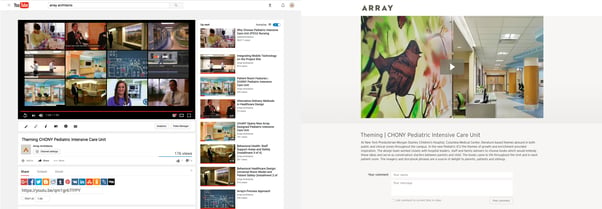The first video-sharing site, ShareYourWorld.com, founded in 1997, was ahead of its time. While it disbanded in 2001 due to bandwidth limitations and financial insecurity, it paved the way for sites like YouTube to “go viral”. When computer and videography technologies began to catch up to one another in the early 2000s, internet-based video began to surpass the presence of the television commercial in the home, and certainly in the workplace. Marketing teams of all sizes are taking advantage of this timing and putting commercial video content online.
The digital age has allowed consumers to access this content wirelessly, giving us freedom of choice. For instance, consumers can occasionally swap a sneezing panda video with a three-minute video discussing a project similar to their own during those spare moments between meetings.
When Array rebranded in 2012, new focus was placed on knowledge sharing, and the goal was to provide clients with enhanced value beyond our immediate architectural and interior design services. As Array’s videographer, I work with our thought leaders to create videos that are not only informative of our services, but also engage clients based on need. Our videos are meant to address pain points for our clients and partners, creating content our audiences want to watch to learn more about A/E/C industry standards and challenges other healthcare facilities face in the design process. With the use of video, clients see Array as an industry leader whose business is to understand client issues and solve their problems – be it throughput, expansion space on a landlocked campus or keeping up with evolving technology. Video put faces to our services and further engages our audience.
When it comes to sharing any marketing content, it is important to keep guests to our site invested in learning more about us and the value we provide, without immediately being distracted by competitors and pop vloggers. While sites like YouTube and Vimeo provide a stepping-stone for video marketing to expand its horizons beyond television commercials, these sites are also responsible for losing viewers after one video. An embedded YouTube video on Array’s blog page, for example, would provide a call to action to view a related video on YouTube that might not be an Array creation, followed by another and another, distancing us further and further from our viewers by showing content that doesn’t necessary relate at all to our brand and our value proposition.
This is why Array switched to Wistia as our video-sharing platform. Much like watching television in one’s living room, a Wistia video-viewing experience is free of distracting ads, framing the video with negative space and a short, or long description, as dictated by the host. The host can also control which prompts come to their viewer and at what point during a video. At the end of play, our videos on Wistia sometimes send viewers to the next video in the series. Other times, viewers will be offered a link to our Knowledge Sharing page, where they can dig deeper into our problem-solving strategies.

As a content creator, I like knowing that we are sharing our videos on a platform that will keep guests looking at Array’s content. When a client is interested in our differentiators and we can reach them with an innovative video, it is our responsibility to keep the content focused, without stimulation overload and rampant distraction. It’s all part of being a good host.
Click the button below to view all of Array's videos.


